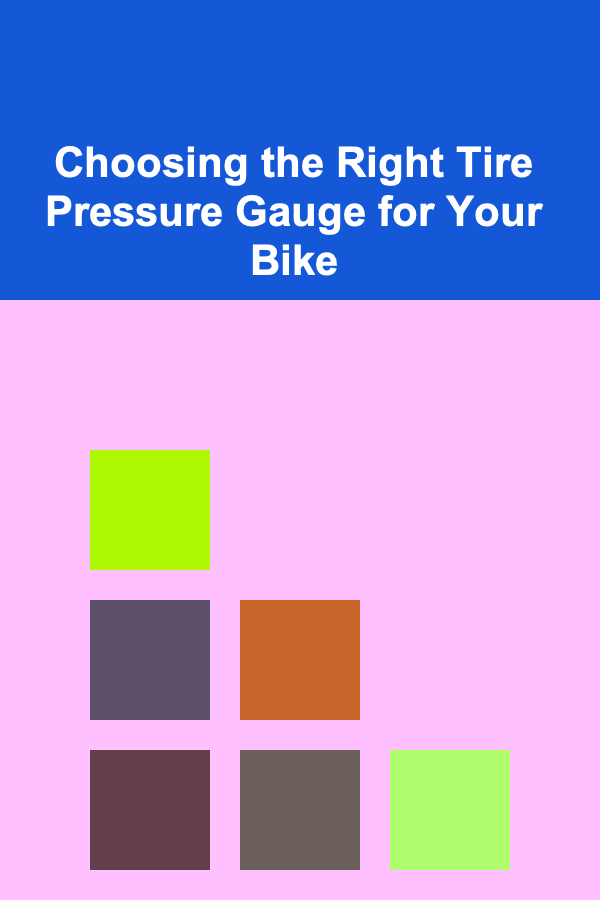
Choosing the Right Tire Pressure Gauge for Your Bike
ebook include PDF & Audio bundle (Micro Guide)
$12.99$5.99
Limited Time Offer! Order within the next:

Maintaining the correct tire pressure is crucial for optimal cycling performance, safety, and tire longevity. Overinflated tires can lead to a harsh ride and increased risk of blowouts, while underinflated tires result in increased rolling resistance, sluggish handling, and a higher chance of pinch flats (snake bites). Therefore, having an accurate and reliable tire pressure gauge is an indispensable tool for any cyclist, from casual riders to seasoned professionals. This article delves into the intricacies of selecting the best tire pressure gauge for your specific needs, covering various types, features, and considerations to ensure you make an informed decision.
Why Accurate Tire Pressure Matters
Before diving into the specifics of tire pressure gauges, it's essential to understand why maintaining correct tire pressure is so vital:
- Performance: Optimal tire pressure minimizes rolling resistance, allowing you to ride faster and more efficiently. Underinflated tires create more surface area contact with the road, increasing friction and requiring more energy to propel the bike forward.
- Handling: Proper tire inflation improves handling and control, especially when cornering or riding on uneven surfaces. Underinflated tires can feel sluggish and unstable, while overinflated tires can make the bike feel skittish and less responsive.
- Comfort: Correct tire pressure significantly impacts ride comfort. Overinflated tires transmit more road vibrations to the rider, resulting in a harsh and uncomfortable experience. Slightly lower pressures, within the recommended range, can absorb bumps and improve ride quality.
- Puncture Protection: Underinflated tires are more susceptible to pinch flats, also known as snake bites. This occurs when the tire is compressed against the rim upon impact with a sharp edge (like a pothole), pinching the inner tube and causing a puncture. Maintaining adequate pressure helps prevent this.
- Tire Longevity: Consistently riding with underinflated tires can cause premature tire wear and damage, leading to a shorter lifespan. The increased friction and deformation of the tire carcass put undue stress on the tire's structure.
Types of Tire Pressure Gauges
Tire pressure gauges come in various forms, each with its own advantages and disadvantages. Understanding the different types will help you narrow down your choices.
1. Stick Gauges (Pencil Gauges)
Stick gauges are the most basic and often the least expensive type of tire pressure gauge. They consist of a calibrated rod that extends from a cylinder when pressure is applied. The reading is indicated by the position of the rod relative to a scale.
Pros:
- Affordable: Stick gauges are generally the cheapest option.
- Compact: They are small and easy to carry in a saddlebag or pocket.
- Simple to use: The operation is straightforward.
Cons:
- Accuracy can be questionable: Stick gauges are known to be less accurate than other types, especially at lower pressures. The internal spring can degrade over time, affecting accuracy.
- Difficult to read: The small scale and reliance on precise rod positioning can make it difficult to obtain an accurate reading, especially in low light conditions.
- Durability issues: The simple construction can make them susceptible to damage.
Best for: Cyclists on a very tight budget who need a basic, portable gauge for occasional use. Not recommended for riders who require precise pressure readings.
2. Dial Gauges
Dial gauges use a needle that moves across a calibrated dial to indicate the tire pressure. They are generally considered more accurate and reliable than stick gauges.
Pros:
- Improved accuracy: Dial gauges are generally more accurate than stick gauges, providing more reliable readings.
- Easier to read: The larger dial is easier to read than the small scale on a stick gauge.
- More durable: Dial gauges tend to be more robust than stick gauges.
Cons:
- More expensive: Dial gauges are typically more expensive than stick gauges.
- Can be bulky: Some dial gauges can be relatively large and less convenient to carry.
- Mechanical calibration: Like stick gauges, dial gauges rely on mechanical components that can drift over time, requiring recalibration (though less frequently than stick gauges).
Best for: Cyclists who prioritize accuracy and ease of reading over absolute portability. Suitable for both recreational and serious riders.
3. Digital Gauges
Digital gauges use electronic sensors to measure tire pressure and display the reading on a digital screen. They are generally the most accurate and feature-rich type of tire pressure gauge.
Pros:
- High accuracy: Digital gauges offer the highest level of accuracy, providing precise pressure readings.
- Easy to read: The digital display is clear and easy to read, even in low light conditions.
- Advanced features: Many digital gauges offer additional features, such as multiple units of measurement (PSI, BAR, kPa), pressure release valves, and memory functions.
Cons:
- Most expensive: Digital gauges are the most expensive option.
- Require batteries: They require batteries to operate, which need to be replaced periodically.
- Potentially less durable: The electronic components can be more susceptible to damage from drops or extreme temperatures compared to purely mechanical gauges.
Best for: Cyclists who demand the highest level of accuracy and appreciate advanced features. Suitable for serious riders, racers, and anyone who wants the most precise pressure control.
Key Features to Consider
Once you've decided on the type of gauge, consider these key features to find the best fit for your needs:
1. Accuracy
Accuracy is paramount. A tire pressure gauge is only useful if it provides reliable readings. Look for gauges with a stated accuracy of +/- 1 PSI or better. Read reviews and compare specifications to get a sense of real-world accuracy. Consider investing in a calibration tool or having your gauge professionally calibrated periodically to ensure it remains accurate.
2. Measurement Range
Ensure the gauge's measurement range covers the typical tire pressures you use. Road bike tires often require higher pressures (80-130 PSI) than mountain bike tires (25-50 PSI). Some gauges are specifically designed for high-pressure or low-pressure applications. A gauge with a range that comfortably encompasses your typical pressure range will provide more accurate readings within that range.
3. Units of Measurement
Most gauges display pressure in PSI (pounds per square inch), but some also offer other units like BAR or kPa. Choose a gauge that displays the units you are most familiar with and prefer to use. The ability to switch between units can be useful, especially if you're traveling or using tire pressure recommendations from different sources.
4. Valve Compatibility
Bicycle tires primarily use two types of valves: Presta (French) and Schrader (American). Some gauges are designed to work with only one type of valve, while others are compatible with both. Ensure the gauge you choose is compatible with the valves on your bike tires. Dual-head gauges, which have separate openings for Presta and Schrader valves, offer the most versatility.
5. Ease of Use
Consider how easy the gauge is to use. Can you easily attach it to the valve without leaking air? Is the display clear and easy to read? Is the gauge comfortable to hold and operate? Look for features like a swiveling head, a long hose (for floor pumps), and a comfortable grip. The attachment mechanism should create a secure and airtight seal on the valve.
6. Durability
Choose a gauge that is built to withstand regular use and potential bumps and drops. Look for gauges made from durable materials, such as metal or reinforced plastic. Consider the construction of the gauge, particularly the connection points and the housing of the measuring mechanism. A rugged gauge will last longer and provide more reliable performance.
7. Portability
If you plan to carry the gauge with you on rides, consider its size and weight. Stick gauges are the most portable, while some dial and digital gauges can be bulky. Choose a gauge that is small and light enough to fit comfortably in your saddlebag or pocket.
8. Pressure Release Valve (Bleed Valve)
A pressure release valve, also known as a bleed valve, allows you to gradually release air from the tire to achieve the desired pressure. This is particularly useful if you accidentally overinflate the tire. Some gauges have a simple button, while others have a more precise dial for controlled air release.
9. Backlight
A backlight on a digital gauge makes it easier to read the display in low light conditions. This is a valuable feature for riders who often ride in the early morning or evening.
10. Hose Length (for Floor Pumps)
If you are looking for a gauge to use with a floor pump, consider the length of the hose. A longer hose will provide more flexibility and make it easier to reach the tire valve.
11. Digital Gauge Specific Features
If opting for a digital gauge, look for these additional features:
- Auto Shut-off: This feature helps conserve battery life by automatically turning off the gauge after a period of inactivity.
- Memory Function: Some digital gauges can store previous pressure readings, which can be useful for tracking tire pressure over time.
- Replaceable Batteries: Ensure the gauge uses readily available and affordable batteries.
- Battery Indicator: A low battery indicator alerts you when the batteries need to be replaced.
Choosing the Right Gauge for Your Cycling Discipline
The best tire pressure gauge for you will also depend on the type of cycling you do:
Road Cycling
Road cyclists typically use higher tire pressures for optimal speed and efficiency. Accuracy is crucial for achieving the desired ride characteristics. A digital or dial gauge with a high-pressure range (up to 160 PSI or higher) is recommended. A pressure release valve can be very helpful for fine-tuning the pressure.
Mountain Biking
Mountain bikers typically use lower tire pressures for improved traction and comfort on rough terrain. Accuracy is still important, but the pressure range is lower (typically 20-50 PSI). A digital or dial gauge with a low-pressure range is recommended. A pressure release valve is essential for adjusting pressure on the trail.
Gravel Cycling
Gravel cyclists often use a wider range of tire pressures depending on the terrain and conditions. A digital or dial gauge with a mid-range pressure range (30-80 PSI) is a good choice. A pressure release valve is helpful for adjusting pressure on the go. Portability is also a consideration, as gravel rides often involve long distances and remote locations.
Commuting
Commuters need a reliable and durable gauge that is easy to use. A dial or digital gauge is recommended. Portability is important if you want to carry the gauge with you on your commute. Consider a gauge with a dual head to accommodate both Presta and Schrader valves, as some commuter bikes may have different valve types.
Tips for Using Your Tire Pressure Gauge
To ensure you get accurate readings and prolong the life of your tire pressure gauge, follow these tips:
- Check your tire pressure regularly: Check your tire pressure before each ride, or at least once a week.
- Use the same gauge consistently: Different gauges may have slight variations in accuracy. Using the same gauge consistently will help you maintain a consistent pressure level.
- Check tire pressure when tires are cold: Tire pressure increases as the tires heat up during riding. Check your tire pressure when the tires are cold for the most accurate reading.
- Store your gauge properly: Store your gauge in a dry and safe place to protect it from damage.
- Calibrate your gauge periodically: Consider calibrating your gauge periodically, especially if you use it frequently or suspect it may be inaccurate. Some bike shops offer calibration services, or you can purchase a calibration tool.
- Avoid dropping the gauge: Dropping a gauge, especially a dial or digital gauge, can damage its internal components and affect its accuracy.
- Read the manufacturer's instructions: Always refer to the manufacturer's instructions for proper use and maintenance of your gauge.
- Replace worn or damaged gauges: If your gauge is damaged or no longer providing accurate readings, replace it with a new one.
- Practice proper valve insertion technique: Ensuring a secure and airtight seal between the gauge and the valve is critical for accurate readings. Experiment to find the best angle and pressure for a good seal.
Conclusion
Selecting the best tire pressure gauge for your bike requires careful consideration of your cycling needs, budget, and desired features. By understanding the different types of gauges available, the key features to look for, and the specific requirements of your cycling discipline, you can make an informed decision and choose a gauge that will help you maintain optimal tire pressure for performance, safety, and comfort. Remember that investing in a quality tire pressure gauge is an investment in your overall cycling experience.

How to Create a Minimalist Home on a Tight Budget
Read More
How to Make Freezer-Friendly Soups and Stews
Read More
How to Make Money Online as a Podcast Guest Booker: 10 Actionable Ideas
Read More
How To Play the Bagpipes: Learning the Chanter
Read More
How to Integrate Your Blog Planner with Your Social Media Strategy
Read More
How to Conduct Heuristic Evaluations Like a Pro
Read MoreOther Products

How to Create a Minimalist Home on a Tight Budget
Read More
How to Make Freezer-Friendly Soups and Stews
Read More
How to Make Money Online as a Podcast Guest Booker: 10 Actionable Ideas
Read More
How To Play the Bagpipes: Learning the Chanter
Read More
How to Integrate Your Blog Planner with Your Social Media Strategy
Read More